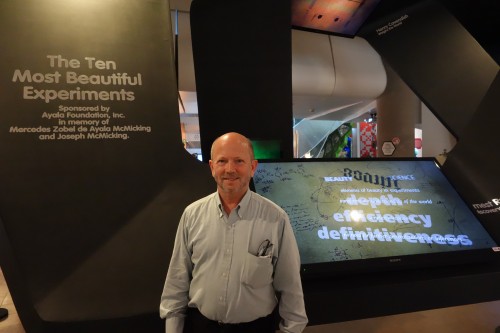
Inspired thinking – Robert P Crease in front of an exhibit at Manila’s Mind Museum that was inspired by Physics World readers.
By Robert P Crease in Singapore
It’s not often that you come across a museum exhibit based on a Physics World article. But I did on Saturday at the Mind Museum – an extraordinarily beautiful and original science museum in Taguig, on the outskirts of Manila in the Philippines.
Not only that, the exhibit is right at the entrance. You may recall that I once asked Physics World readers for their thoughts on the 10 most beautiful experiments and wrote up the results in an article in September 2002. The project turned into a book, The Prism and the Pendulum: The Ten Most Beautiful Experiments in Science, which came out the following year and which Physics World reviewed.
Maria Isabel Garcia, who was planning exhibits for the then-future Mind Museum, saw the article and book, and created an exhibit based on it, consisting of videos and explanations of each of the 10 experiments, along with a sculpture designed by the Philippine artist Daniel de la Cruz.
Garcia – who among other things writes the weekly “Science Solitaire” column for social-news network Rappler – took me through the museum. All its exhibits, in fact – apart from one globe and one T. rex skeleton – are original, interactive and sprang from collaborations between scientists and Philippine artists.
While at the museum, I played a harp where the “strings” are laser beams that made notes when I interrupted them with my fingers. I used a mock Gutenberg press to print out the Mind Museum logo as a souvenir. I twiddled knobs to change quantum numbers on a 3D visualization of hydrogen-atom orbitals. I sent my wallet through a mock-up of an airport X-ray scanner. “I thought, it’s a shame that they won’t tell you how they work at airports,” Garcia told me, “so I decided to make one here so that even kids can find out.”
This museum and the Exploratorium have the most innovative science exhibits I’ve seen. I plugged my finger into a device that monitored my pulse as I read a series of literary passages – ranging from the beautiful to the racy – selected by a panel of Philippine writers. Sure enough, one from Sappho sent my pulse up two beats per minute, while another by Lawrence Durrell made it shoot up by five.
The museum’s layout cleverly connects each area of science with related others. A “light bridge” connects the Atom Gallery at one end of the museum with the Universe Gallery on the other. Along the way are interactive exhibits about waves, including “piano stairs” (black and white, of course) that play when you walk on them, and a Hertz induction-coil transmitter that you can use to make a spark jump a metre.
We were joined by Pecier Decierdo, a graduate student in astronomy at the University of the Philippines who works as a “Mind Mover”, or what other museums call tour guide. Decierdo helped to design several exhibits, including an orrery and one on general relativity. I sat in on a talk he gave to 12 fidgety elementary school kids in half-English, half-Tagalog about planets and constellations in the museum’s small planetarium. “These look great if you look at pictures of them or if you google them,” he said, his silhouette plastered against the evening sky, “but it’s way, way more beautiful if you see them with your own eyes!”
The museum has an active outreach programme that includes “sidewalk astronomy” events and a science-fiction book club (“Mind Readers”) run by Decierdo. The Mind Museum is the first remote partner of the World Science Festival in New York, and this week will be participating in the event via live feeds on 28 and 31 May, linking to events taking place 12 hours earlier in New York.
Other community events sponsored by the museum include the “Café Scientifique” – a series of informal discussions staged in the open-air plaza in front of the museum. These, too, are inventive. On Einstein’s birthday this year, the Philippine astrophysicist Reinabelle Reyes talked about general relativity and even took the audience through some equations. Last summer, the Philippine-American scientist Blaise Kuo Tiong skyped in to the plaza from his Antarctica laboratory. When he introduced Tiong, Decierdo joked that the ambient temperature was the same (40 degrees) in both places – but below zero at the lab and above zero at the museum.
It was that temperature, as well, that Saturday afternoon when I gave a Café Scientifique talk on the good and bad aspects of quantum mechanics in popular culture – another topic of several Physics World articles. But thanks in part to a gentle breeze that blew through the plaza, the crowd of about 100 remained attentive and engaged, and the discussion continued for well over an hour.
Sounds like an amazing exhibit! I would definitely love to see it. Seems like I’d learn a lot! Thanks for sharing.
Can’t wait to visit the Mind Museum this coming Saturday with my kids. I’m sure they will enjoy it.